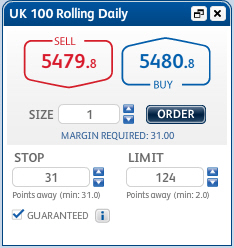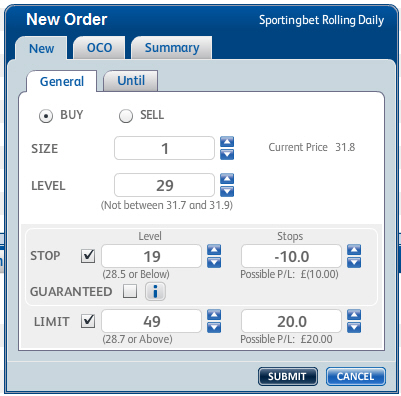Understanding Trade Tickets and Order Tickets
Dec 9, 2011 at 5:27 pm in Orders by
I spend a lot of time writing about spread betting techniques; but you can only apply those techniques at all if you actually press the TRADE and / or ORDER buttons on the spread betting platform. You need to understand the tools as well as the techniques, and the tools I am referring to are the trade tickets and order tickets via which you can buy or sell now (in the case of trade tickets) or in the future (in the case of order tickets).
So in this article I go “back to basics” by describing the form and function of typical spread betting trading tickets and order tickets.
In my examples I have used Capital Spreads trade tickets and order tickets as my demonstration vehicles, because they offer a super-set of the options provided by trading tickets and order tickets on other platforms. This is also the spread betting platform I am using for my Trading Trail public trading run.
Trade Ticket
The following figure shows a typical trade ticket that you will be presented with when you click the TRADE button for your chosen financial instrument (often called a “market”) on the Capital Spreads platform. In this case I have chosen to trade the UK 100 Rolling Daily.
 On this particular platform, only the top portion is shown initially so that you can BUY or SELL quickly at £1-per-point with a single button click. Or, with a few more button clicks if you first choose to specify a different trade SIZE.
On this particular platform, only the top portion is shown initially so that you can BUY or SELL quickly at £1-per-point with a single button click. Or, with a few more button clicks if you first choose to specify a different trade SIZE.
Pressing the ORDER button on the trade ticket — make sure you do this before clicking BUY or SELL — reveals the additional STOP and LIMIT fields. The STOP field allows you to attach a protective stop order to the newly-opened trade, and to guarantee it (at a cost) by checking the GUARANTEED check-box. Although I tend not to do so myself, you can enter a value into the LIMIT field at which you intend to close the trade for a profit. Note that on this platform these fields are STOP and LIMIT distances rather levels, so this trade will be concluded when it has generated a 31-point loss or a 124-point profit relative to the opening price. On another platform, the STOP level (for example) may be an absolute price, so you should take care not to inadvertently attach a stop order that doesn’t stop you out until the FTSE has crashed to a price level of just 31 — by which time it will be too late!
When you utilise the facility to GUARANTEE your attached stop order, the trade ticket will mandate a minimum stop distance, which in this case was 31 points from the entry price. A tighter stop order could have been applied, but not guaranteed.
Order Ticket
The following figure shows a typical order ticket that you will be presented with when you click the ORDER button for your chosen financial instrument (often called a “market”). In this case I have chosen to place an order on Sportingbet shares… purely for demonstration.
 You can see that the ORDER ticket allows us to choose between creating a BUY order or a SELL order, to specify a trade SIZE, and to specify a LEVEL at which we wish to execute the order. Note that in this example I have chosen to BUY when the price of Sportingbet shares falls from the current price of 31.8 to a price of 29; thus this is a LIMIT BUY order. If I had chosen to SELL when the price fell to 29 it would have been a STOP SELL order. If I had chosen an entry price higher than the current 31.8 then it would have been a STOP BUY or LIMIT SELL order, depending whether I had chosen to BUY or SELL at the higher price.
You can see that the ORDER ticket allows us to choose between creating a BUY order or a SELL order, to specify a trade SIZE, and to specify a LEVEL at which we wish to execute the order. Note that in this example I have chosen to BUY when the price of Sportingbet shares falls from the current price of 31.8 to a price of 29; thus this is a LIMIT BUY order. If I had chosen to SELL when the price fell to 29 it would have been a STOP SELL order. If I had chosen an entry price higher than the current 31.8 then it would have been a STOP BUY or LIMIT SELL order, depending whether I had chosen to BUY or SELL at the higher price.
The significant point here is that on this particular spread betting platform (but not all) you do not explicitly choose between LIMIT and STOP opening orders; this is implied by the parameter values you enter.
In the lower half of the order ticket you do set STOP and LIMIT prices explicitly, which are the prices at which this trade will close, but it’s optional. In this example I have chosen to stop-out with a loss of £10 or to run my profit until it reaches £20, and I have chosen not to guarantee my stop order.
Good Until
You will have noticed in the above figure a tab labelled “Until” which, when selected, allows you to set a time period for which the order is valid. It is common for order tickets to allow you to mark your orders as being good until CANCELLED (my preference), END OF DAY (for day traders), or a specific DATE.
One Cancels Other (OCO)
You will also have noticed in the above figure a tab labelled “OCO”, which means “One Cancels Other”. This allows you to place an additional — usually opposing — order with the intention that one but not both orders will be executed. With the FTSE trading within a range, you might decide to place an order to BUY above the trading range (in anticipation of an upside breakout) with an opposing OCO order to SELL below the trading range (in anticipation of a downside breakout). If your BUY order executes, your SELL order will become irrelevant, and vice versa.
From Tools to Techniques
Now that you have the tools in the form of trade tickets and order tickets, you are fully equipped to try out the techniques in the form of the Financial Trading Patterns that I started documenting here.
Tony Loton is a private trader, and author of the book “Stop Orders” published by Harriman House.

